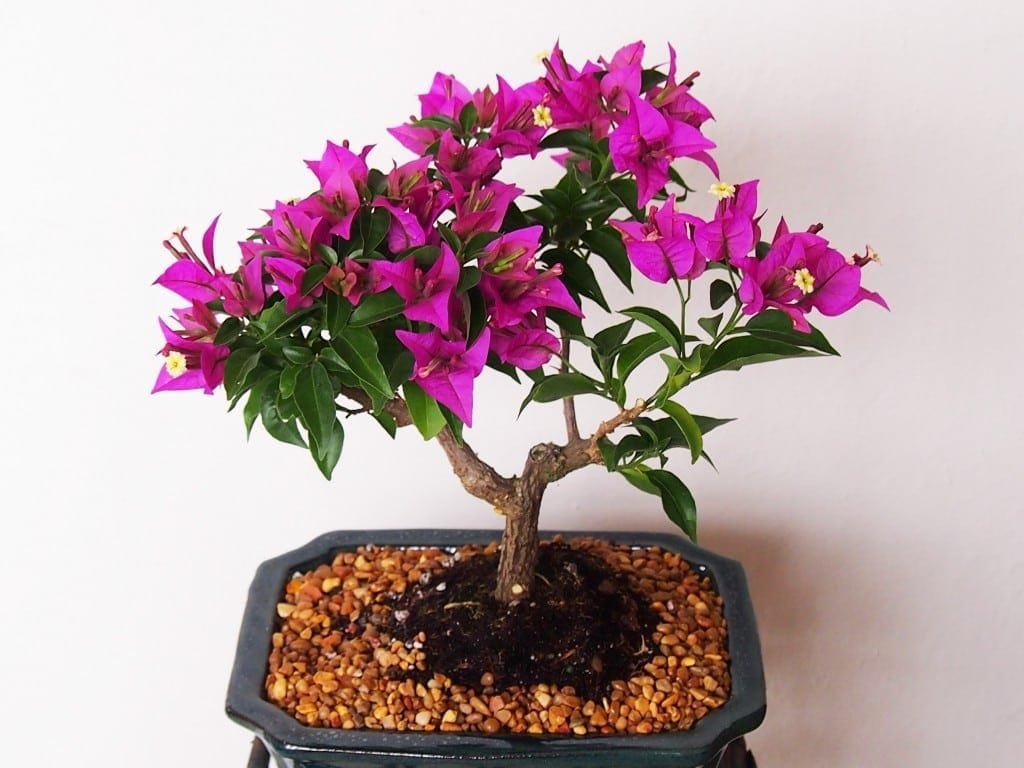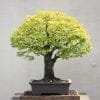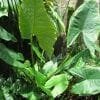Background & History
Bougainvillea Bonsai is a genus of ornamental flowering plants that are native to South America — mainly Peru, Brazil, and Argentina. It is named after the French Navy Admiral, Louis Antoine de Bougainville. Bougainvillea was discovered in 1768 by Philibert Commerco, a French botanist, who accompanied Bougainville on a voyage to circumnavigate the globe.
These striking, woody vines climbing over rocks and trees are perfectly adaptable to a warm climate, where they can thrive all year long, provided there is enough rain. They can grow as tall as 12 meters, and have spiky horns that enable them to easily climb over nearby plants. Their colorful, petal-shaped leaves are their most stunning feature.
The common observer may think that they are part of the flower; however, the actual flowers are the tiny structures in the center of the leaves known as bracts or colored leaves. The miniature flowers inside are yellow in color and provide a visual appeal against the brightly colored bracts.
The species has been crossbred extensively, which explains the variety of colors it can be found in — shades of reds, deep purples, bright pinks, yellows, and whites.
There is a discrepancy in the classification of bougainvillea as experts have named anywhere from four to 18 species. However, most taxonomists recognize four species: Bougainvillea Glabra, Bougainvillea Spinosa, Bougainvillea Peruviana, and Bougainvillea Spectabilis. Bougainvillea Glabra, which is known as paper flower, is the most common and most widely cultivated.
| Scientific/Botanical Name | Bougainvillea glabra |
| Description | The bougainvillea is an ornamental and woody vine that is indigenous to South America. However, it is now grown in many parts of the world. It can grow to a great height under ideal conditions. It has been heavily crossbred, and is now available in many different colors. The leaves are attractive, and shaped like flower petals. |
| Position | Grow in full sun outdoors. Lack of optimal sunlight will lead to decreased leaf production. |
| Watering | Water the plant well, but make sure it has excellent drainage. Excessive wetness can lead to fungal growth, which is fatal to the plant. |
| Feeding | Feed with a nitrogen-rich fertilizer to ensure maximum leaf growth. |
| Leaf and Branch Pruning | Prune to desired shape during the growth phase only. Never prune the plant when it is dormant. |
| Re-potting & Growing Medium | Re-pot late in the spring. Prepare the plant for re-potting by watering it well two days prior to re-potting, and then let it dry out just before it is re-potted. Use a mixture of sand, pumice and compost-rich soil for growing the plant. |
| Wiring | Wires should be used only to train the newer branches. Older branches will break if wiring is attempted. |
| Notes | Many people do not know that the colorful flowers, called bracts, are actually the leaves of the bougainvillea. The real flowers are yellow and rather small. They are found in the center of the bracts. |
Cultivation
Bougainvillea was spread across Europe after its discovery, cultivated in nurseries throughout different parts of the land. It was also later shipped to various colonies of England across different regions of the world.
Categorized as tropical evergreens, bougainvilleas are often popular in warmer climates where they are grown all year round. In regions with colder winters or dropping temperatures, they tend to become fully deciduous or semi deciduous — seasonally losing their leaves and flowers.
Warmer climate regions where they are frequently found include: Thailand, Indonesia, Philippines, Sri Lanka, Malaysia, Pakistan, Taiwan, Vietnam, Aruba, Ethiopia, India, Turkey, Greece, Spain, Singapore, Cyprus, Central America, the Persian Gulf, Australia, southern and southwestern United States, the Caribbean, and the Mediterranean.
Bougainvillea has also flourished since its transportation to other locations with warm climate in the world, becoming a “transplanted native” and spreading everywhere rapidly. For example, it grows wildly at some places in Southern California.
Bougainvillea can be picked up from local nurseries, or conveniently taken from the wild if available. They are easy to collect due to their shallow root system and can be replanted from a thick cutting with little effort.
Care Instructions
Potting
Ideally, the plant should be grown in soil before being potted. The roots of bougainvillea are very brittle and thin when not developed, which makes it easy for them to break off during potting.
It is best to wait until the branches are thick and the roots are strong enough to withstand moving before considering potting. The best time to move the plant to a pot is during late Spring when it is in rapid development.
Otherwise, it might be difficult for the plant to recover and survive after transporting. Water the soil two days in advance and let it dry. After potting, the plant might lose some leaves, but they should begin to regrow quickly.
Planting bougainvillea in the soil before transferring it to a pot has another advantage: the trunk of the plant can grow thicker due to the lateral spread of the roots, which tend to go far distances. A pot is too confining for the early development of this vine. Generally, the longer the roots the thicker the plant’s trunk.
When choosing a pot, always opt for a larger size to provide the roots ample space to grow and thrive. Choose a glazed color pot to create color contrast with the exquisite leaves of the plant, or place it in an unglazed pot to give the plant a rich, earthy look and feel. Also, remember to use pots that have sufficient drainage and moisture retaining qualities for optimum growth.
Soil
Organic fertilizer rich in nitrogen is the preferred choice for bougainvilleas because they require high amounts of nitrogen to grow their beautifully colored leaves. Bougainvilleas perform well with 40% of organic matter in the soil; the remaining matter may be agricultural pumice, coarse sand, decomposed granite, or a mixture of all of these.
Environment
1. Light
Bougainvilleas prefer full sunlight and like to be kept outside in the sun or indoors where an adequate amount of sunlight available. Some harsher areas, such as desert-like environments, can be a bit tough on the plant, so make sure to be careful. If the plant does not receive enough sunlight, it will grow without any leaves.
2. Water
Water drainage is essential for bougainvilleas, as roots kept in damp and moist soil can potentially grow fungus. However, it is important to water the plant (link to watering bonsai page) consistently, especially when there is a lot of foliage on the plant.
3. Temperature
Bougainvilleas are best kept above 40 degrees Fahrenheit; anything below this temperature must be monitored or moved to a warmer area. When pruning or potting, wait for a temperature of approximately 50 degrees Fahrenheit.
Pruning
Pruning is advised to shape the plant as needed; however, caution must be taken to avoid damaging the plant. Pruning should not be done while the plant is dormant; the best time to prune is when it is healthy and in active growth. It can be reduced and cut to one or two leaves.
New branches can be trained to take shape on a wire, but older ones become thick and cannot be shaped without breaking. Except for formal upright (link to bonsai tree styles page), you can shape the viney plant whichever way possible.
Diseases & Insects
Bougainvilleas are generally protected from all pests except aphids. The main cause of death for this plant is fungus, which forms on its roots due to overwatering. Also, keep a lookout for the usual garden pests.


